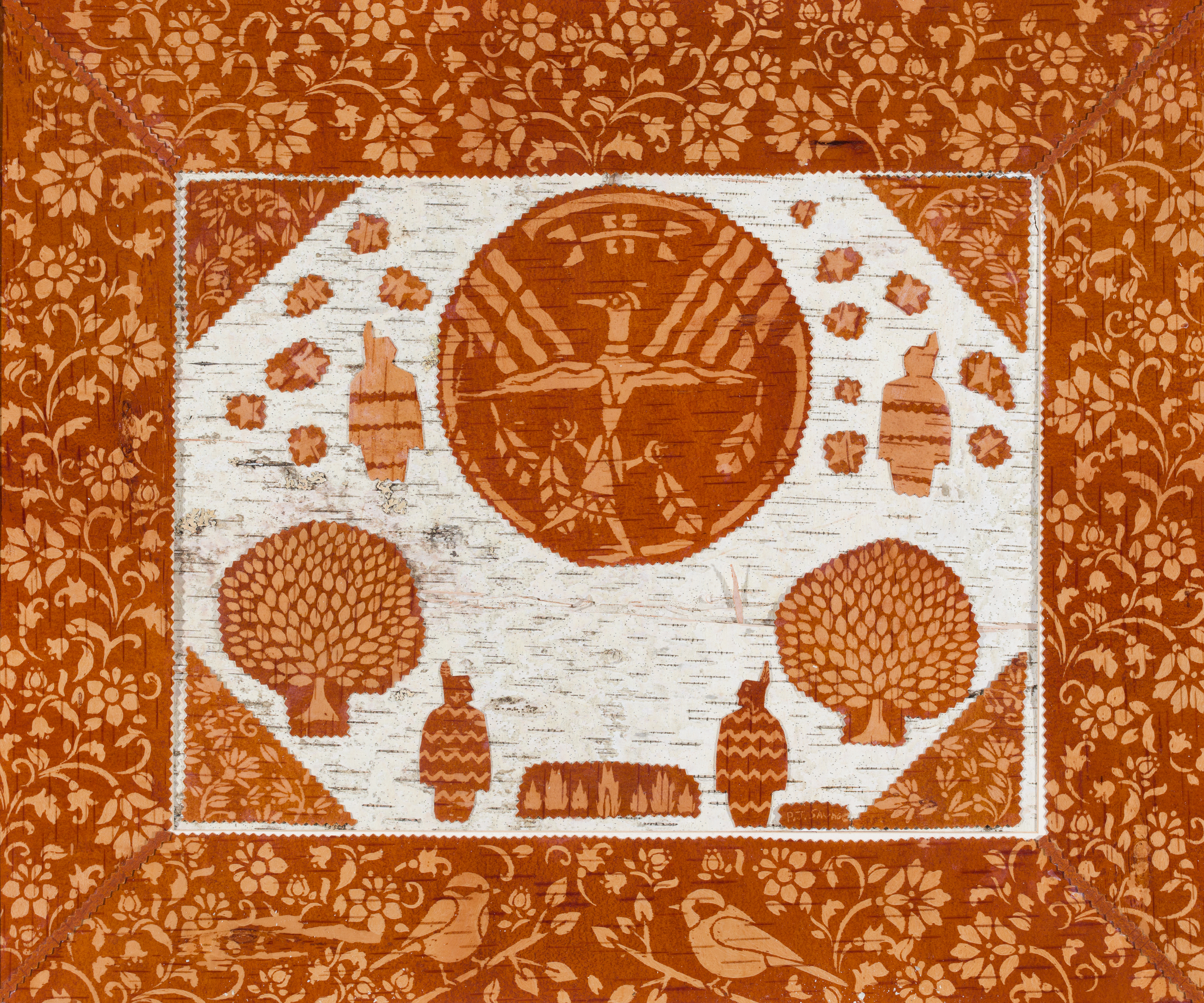
COMMUNITY ART
The Fond du Lac Reservation community has been fortunate to have the insight to sponsor unique art projects for the community. Community is built through art projects and traditional art forms which are kept alive. This exchange of ideas and skills contributes to a thriving creative community. The traditional art forms continue to be passed down to the next generations.
The Fond du Lac Reservation community has had the foresight to support unique art projects, which serve to foster a sense of unity and preserve traditional art forms. This exchange of ideas and skills contributes to the vitality of our creative community, while the passing down of traditional art forms ensures their continuity for generations to come.
CANOE
The birch bark canoe plays an intricate role in Ojibway life. The canoe gathers food such as wild rice and serves as transportation along the lakes and streams. There were two basic types of canoes used during the fur trade. The master canoe was 36 feet long and traveled along the Great Lakes. In the north, a smaller canoe was used for river traveling. It held 4 to 6 people.
The canoe in this exhibit was a Fond du Lac Reservation community project. Many community members came to participate in the building of the canoes. By learning and watching the many steps in building a birch bark canoe, others were inspired to go on and create other art projects: cradleboards, cradleboard parts, and Lacrosse sticks were fashioned using a steam box process to bend black ash wood.
The birch bark canoe is integral to Ojibway life, serving as both a practical tool and a cultural symbol. During the fur trade era, two distinct types were utilized: a large 36-foot master canoe designed for traversing the expansive waters of the Great Lakes, and a smaller variant ideal for navigating rivers, accommodating 4 to 6 individuals.
In this exhibit, a meticulously crafted birch bark canoe, borne out of a collaborative effort within the Fond du Lac Reservation community, takes center stage. Engaging numerous community members, this project not only celebrates tradition but also serves as a catalyst for artistic exploration. The process of constructing the canoe, with its intricate steps and attention to detail, has inspired participants to embark on additional creative endeavors. Notably, the utilization of a steam box technique for shaping black ash wood has facilitated the creation of other culturally significant artifacts such as cradleboards and Lacrosse sticks, further enriching the cultural tapestry of the Ojibway people.
CEDAR MAT
This cedar bark mat was made from the inner bark of a cedar tree and woven on a standing frame loom. Ojibway’s are known for their mats made from natural materials. Mats were used to sleep on, for floor covering, and for the inside walls of homes. A cedar tree is cut down, and the bark is stripped off the tree. It is the inner bark that is used to make strips to be woven into a mat. To get beautiful patterns woven into the mat some of the strips of bark are dyed a darker color. Geometric designs are formed by different colored strips.
The cedar mat in this exhibition originated as a community art project supported by the Fond du Lac Tribal and Community College. After many years, it was woven within the Fond du Lac community and underwent revisions through the collaborative efforts of numerous community members as part of this project.
This cedar bark mat was crafted using the inner bark of a cedar tree and woven on a standing frame loom. The Ojibwe people have a rich tradition of creating mats from natural materials. Historically, these mats served various purposes such as sleeping surfaces, floor coverings, and interior wall decorations in homes.
To produce the mat, a cedar tree is felled, and its bark is carefully removed. The inner bark is then processed into strips suitable for weaving. In order to achieve intricate patterns, some of these strips are dyed to a darker shade. Different colored strips are skillfully woven together to create geometric designs.
The cedar mat showcased in this exhibition originated as a community art project facilitated by the Fond du Lac Tribal and Community College. Over the years, it underwent multiple revisions, with input from numerous community members, as part of this collaborative endeavor.
CRADLEBOARD
Cradleboards are used to keep babies safe from the elements. Every culture has taken great care of a new baby to keep it safe and strong. The cradleboard also contained a moss bag to keep the baby tightly swaddled. Swaddling was one of the first important steps done for the baby. Every culture shares a swaddling tradition. Beautifully beaded designs decorated the precious moss bags. The top of the cradleboard was sometimes decorated with carvings. The roll bar would have trinkets dangling down for the baby’s amusement. The bottom curved U-shaped board keeps the baby in place on the backboard. Tradition is kept alive and contemporary inspirations are added to create beautiful, decorated bags to welcome new babies, our most precious gift.
Today because of the canoe-building event on the Fond du Lac Reservation there is a resurgence of steam-bending wood to create more cradle boards. The steam box used to bend the ribs of the birch bark canoe in this exhibition is the same process used to bend cradleboard pieces and lacrosse sticks. Cradleboard-making workshops were conducted at the Fond du Lac Tribal Community College a few years back and now bending lacrosse sticks classes have taken place.
Cradleboards serve as protective enclosures to shield babies from environmental elements. Across cultures, great care has always been taken to ensure the safety and well-being of newborns. Additionally, cradleboards often included a moss bag to snugly swaddle the baby, marking one of the initial steps in their care. Swaddling holds significance across diverse cultural traditions.
Elaborate beadwork adorned the moss bags, while decorative carvings embellished the tops of cradleboards. Dangling trinkets on the roll bar provided entertainment for the baby. The curved U-shaped board at the bottom secured the baby in place on the backboard.
While honoring tradition, contemporary influences are embraced to craft beautifully adorned bags for welcoming newborns, cherished as our most precious gift.
The recent canoe-building event on the Fond du Lac Reservation has sparked a renewed interest in steam-bending wood for creating cradleboards. The steam box utilized to bend the ribs of birch bark canoes, showcased in this exhibition, mirrors the process employed for shaping cradleboard components and lacrosse sticks. Workshops on cradleboard-making were previously held at the Fond du Lac Tribal Community College, and now, classes on bending lacrosse sticks have also been introduced.
FINGER WEAVING
Finger weaving is an ancient weaving tradition that is at least 3,000 years old. It is a weaving process that does not require a loom. The weaver uses their fingers to manipulate the yarns into a pattern. The color and placement of the yarns form the pattern. Common patterns are lightning, arrowheads, and chevrons. Sashes and belts were an important part of the clothing of the Ojibway in the 1700s and 1800s.
Dennis White is an enrolled member of the Lac Courte Oreilles Reservation Wisconsin and holds a master’s degree in mathematics. He is well known for mastering the art of finger weaving and twining techniques. His deep passion for finger weaving has led him to a residency at the Smithsonian Museum of the American Indian in Washington D.C. Dennis’ finger woven belts and twinned bags are in the permanent collection. He is self-taught in the art of the finger-weaving process and willing to share his techniques with anyone. In the past, Dennis has taught workshops all over Minnesota and Wisconsin. As a former teacher and principal, he has taught many classes in finger weaving to his students over the years.
Finger weaving is a time-honored tradition dating back at least 3,000 years, predating the use of looms. In this technique, the weaver manipulates yarns with their fingers to create intricate patterns. The arrangement and colors of the yarns determine the final design, with popular motifs including lightning, arrowheads, and chevrons. Among the Ojibwe people of the 1700s and 1800s, sashes and belts woven using this method held significant cultural importance.
Dennis White, a member of the Lac Courte Oreilles Reservation in Wisconsin, boasts a master's degree in mathematics and is renowned for his mastery of finger weaving and twining techniques. His profound dedication to finger weaving earned him a residency at the Smithsonian Museum of the American Indian in Washington D.C., where his finger-woven belts and twinned bags now reside in the permanent collection. Despite being self-taught, Dennis is enthusiastic about sharing his expertise with others. He has conducted workshops throughout Minnesota and Wisconsin, drawing on his experience as a former teacher and principal to effectively impart the art of finger weaving to his students over the years.

This activity is made possible by the voters of Minnesota through a Minnesota State Arts Board Operating Support grant, thanks to a legislative appropriation from the Arts and Cultural Heritage Fund.